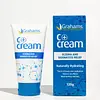What's inside
What's inside
 Key Ingredients
Key Ingredients

No key ingredients
 Benefits
Benefits

 Concerns
Concerns

 Ingredients Side-by-side
Ingredients Side-by-side

Water
Skin ConditioningLanolin
EmollientSqualane
EmollientCetearyl Alcohol
EmollientGlyceryl Stearate
EmollientCaprylic/Capric Triglyceride
MaskingIsopropyl Myristate
EmollientHoney
HumectantSimmondsia Chinensis Seed Oil
EmollientCalendula Officinalis Extract
Skin ConditioningCentella Asiatica Extract
CleansingPhenoxyethanol
PreservativeCaprylyl Glycol
EmollientSodium Stearoyl Glutamate
CleansingSorbitol
HumectantHippophae Rhamnoides Fruit Oil
Skin ProtectingStearic Acid
CleansingCyamopsis Tetragonoloba Gum
Emulsion StabilisingSodium PCA
HumectantXanthan Gum
EmulsifyingTocopherol
Antioxidant3-O-Ethyl Ascorbic Acid
Skin ConditioningLactic Acid
BufferingWater, Lanolin, Squalane, Cetearyl Alcohol, Glyceryl Stearate, Caprylic/Capric Triglyceride, Isopropyl Myristate, Honey, Simmondsia Chinensis Seed Oil, Calendula Officinalis Extract, Centella Asiatica Extract, Phenoxyethanol, Caprylyl Glycol, Sodium Stearoyl Glutamate, Sorbitol, Hippophae Rhamnoides Fruit Oil, Stearic Acid, Cyamopsis Tetragonoloba Gum, Sodium PCA, Xanthan Gum, Tocopherol, 3-O-Ethyl Ascorbic Acid, Lactic Acid
 Reviews
Reviews

Ingredients Explained
These ingredients are found in both products.
Ingredients higher up in an ingredient list are typically present in a larger amount.
Caprylyl Glycol is a humectant and emollient, meaning it attracts and preserves moisture.
It is a common ingredient in many products, especially those designed to hydrate skin. The primary benefits are retaining moisture, skin softening, and promoting a healthy skin barrier.
Though Caprylyl Glycol is an alcohol derived from fatty acids, it is not the kind that can dry out skin.
This ingredient is also used as a preservative to extend the life of products. It has slight antimicrobial properties.
Learn more about Caprylyl GlycolCetearyl alcohol is a mixture of two fatty alcohols: cetyl alcohol and stearyl alcohol. It is mainly used as an emulsifier. Emulsifiers help prevent the separation of oils and products. Due to its composition, it can also be used to thicken a product or help create foam.
Cetearyl alcohol is an emollient. Emollients help soothe and hydrate the skin by trapping moisture.
Studies show Cetearyl alcohol is non-toxic and non-irritating. The FDA allows products labeled "alcohol-free" to have fatty alcohols.
This ingredient is usually derived from plant oils such as palm, vegetable, or coconut oils. There is debate on whether this ingredient will cause acne.
Due to the fatty acid base, this ingredient may not be Malassezia folliculitis safe.
Learn more about Cetearyl AlcoholIsopropyl Myristate is an emollient, thickening agent, and texture enhancer. It is created from isopropyl alcohol and myristic acid.
It is used to help other ingredients be better absorbed. It is also an emollient and may help soften and hydrate the skin.
The comedogenic rating of this ingredient depends on the concentration. Lower amounts results in a lower rating.
Isopropyl Myristate may not be fungal acne safe. It can potentially worsen acne prone skin.
Learn more about Isopropyl MyristateWater. It's the most common cosmetic ingredient of all. You'll usually see it at the top of ingredient lists, meaning that it makes up the largest part of the product.
So why is it so popular? Water most often acts as a solvent - this means that it helps dissolve other ingredients into the formulation.
You'll also recognize water as that liquid we all need to stay alive. If you see this, drink a glass of water. Stay hydrated!
Learn more about Water